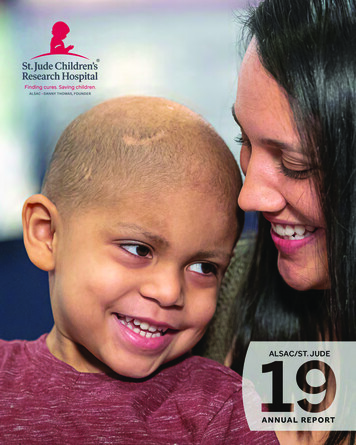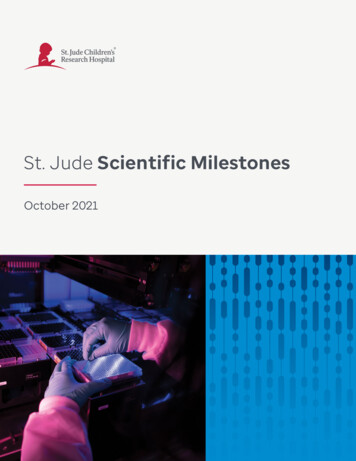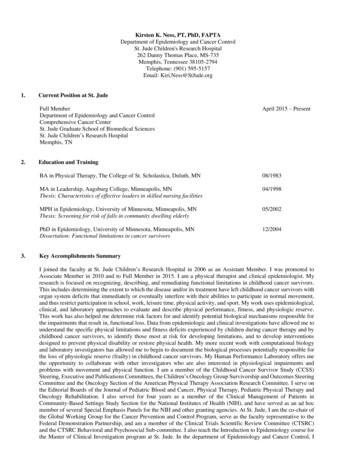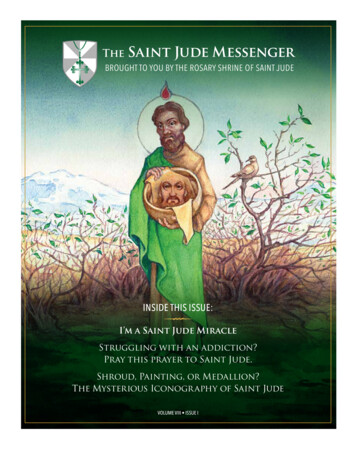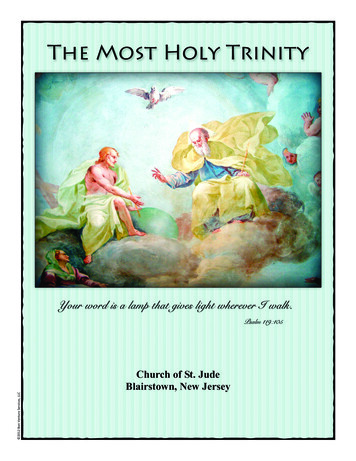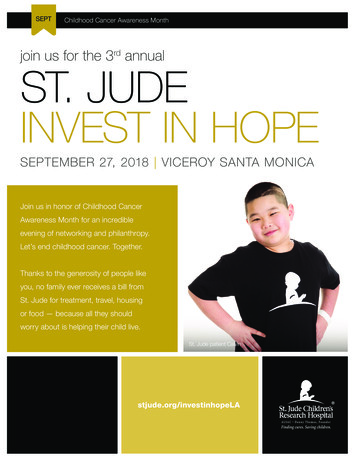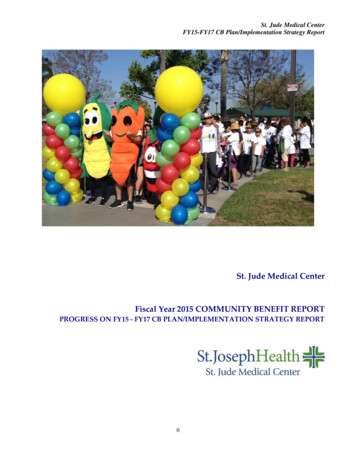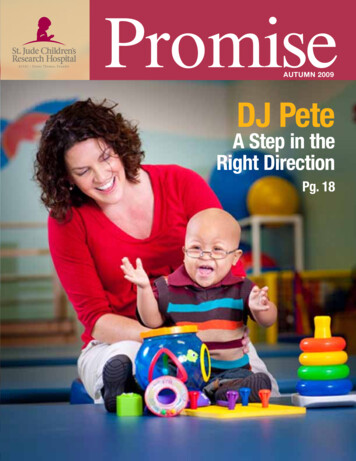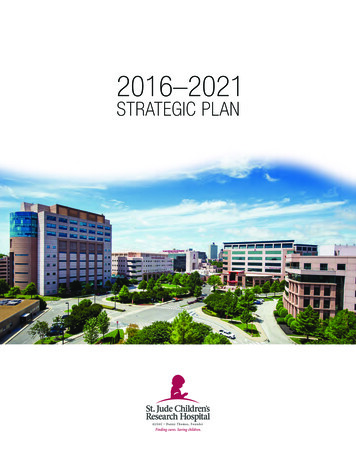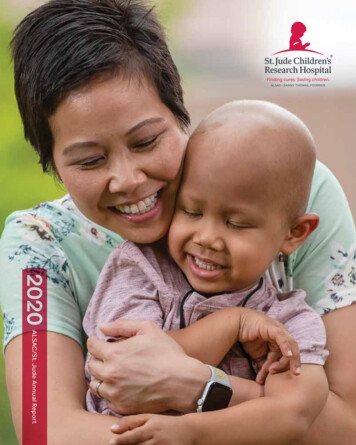
Transcription
ALSAC/St. Jude Annual Report
THE MISSION of St. Jude Children’sResearch Hospital is to advancecures, and means of prevention, forpediatric catastrophic diseasesthrough research and treatment.Consistent with the vision of ourfounder, Danny Thomas, no child isdenied treatment based on race,religion or a family’s ability to pay.ALSAC — American LebaneseSyrian Associated Charities —is the fundraising and awarenessorganization for St. Jude. ALSACis dedicated solely to raising thefunds and awareness necessaryto operate and maintain St. Jude,now and in the future.When 1-year-old Mikayla was diagnosed with acute myeloid leukemia, a cancerof the blood and bone marrow, her parents didn’t know what to expect. “Thereare experiences I think in human life where we run out of tears, and that was oneof them,” said her dad, Juan Manuel. But Mikayla’s family, like all families, neverreceived a bill from St. Jude for treatment, travel, housing or food. Read Mikayla’sstory at stjude.org/mikayla2ALSAC/St. Jude Children’s Research HospitalFinding cures. Saving children. 3
AN IVYLEAGUESTUDENTIN ACLASSOFHERTOWNo understand her mom’s reaction whenCourtney declared she wanted to go athousand miles away for college — “thisnonsense,” as Audrey now calls it, with goodhumor — you have to go back to the beginning.Actually, before the beginning.Six months into her pregnancy, a test showed Audrey’sbaby would be born with sickle cell disease. There was afamily history: A nephew had died from complicationsof sickle cell at age 3. So Audrey wanted the test. Shewanted to know so she could prepare, so she couldgive her baby every chance to thrive with a diseasethat can cause chronic, sometimes debilitating pain.And Courtney has thrived, thanks to St. Jude. “I tellpeople I thank God, and I thank St. Jude secondmost for, really, all aspects of her life,” Audrey said.St. Jude wasn’t just a healing place for Courtney. It’swhere she learned to read, in that difficult summerbetween first and second grade, as she struggledwith the cognitive side effects of her disease.It’s where her personality “bloomed” — her mom’sword — as the chance to participate in St. Jude4ALSAC/St. Jude Children’s Research Hospitalfundraising events drew out this once-timid girl whowent from “being afraid of everything and everybody”to an impromptu singing performance on stage in aballroom full of people. Or, as Courtney said, with alaugh, “and then one day somebody at ALSAC (thefundraising and awareness organization for St. Jude)handed me a microphone, and apparently theycouldn’t get it away ever since.”Sickle cell disease did not define her. She wasn’t aboutto let it confine her. As a high school senior in Memphisshe was accepted at Cornell University. Think of it —an Ivy League education for a girl whose mother onceworried “the child would never read.”Now mom was worried about other things. Aboutthings of great consequence to the parent of a sicklecell patient, like geography. Cornell is in Ithaca, NewYork, a thousand miles from Memphis and the supportsystem with which Courtney grew up. A thousand milesfrom mom, and St. Jude.“I tried to discourage her by telling her, ‘Courtney,you know when you get sick, I’m not going to be ableto blink and be sitting there holding your hand in thehospital,’” Audrey said.Finding cures. Saving children. 5
And there was the weather. Winterscan be harsh in Ithaca, and coldweather can trigger pain episodesin sickle cell patients. It was socold the first time Courtney visitedcampus that she had to borrowa heavy coat from the girl withwhom she was staying — and thatwas in October.“I said, ‘Don’t you think that shouldbe a concern, that you need a bigol’ coat in October, and you havesickle cell disease?’” Audrey said.Nothing would dissuade Courtney.Nothing would dim her hopes. ButAudrey had one more card to play— St. Jude.So when they went to see herdoctors, to talk about thisnonsense of Courtney’s big collegeadventure, Audrey remembersthinking: “Here we go. St. Judehas always provided my solutionto every problem in my life. They’regoing to sit this child down andtell her she should not be goingoff to this cold-weather world.”In retrospect, mom might haveseen it coming. She might haveguessed the place that had caredfor her daughter throughout heryoung life — the place that hadseen her struggle and overcome —would now champion Courtneyin this bold, new chapter.The reaction at St. Jude?Oh, my God, Courtney’s goingto Cornell! Oh, we’re so proudof you! We’re going to find you adoctor up there, don’t you worry.We’re going to take care of you,you’ll be fine.Audrey laughs, looking back.“I’m like, wait a minute. I wasdepending on you all.”My mom hadbeen preparingme my entirelife whetherI was going anhour away or14 hours away.— Courtney6ALSAC/St. Jude Children’s Research HospitalThe Futureof SickleCell DiseaseTreatmentToday, with early diagnosis and useof recently developed treatments,the life expectancy of children withsickle cell disease has increased98 percentresearchSt. Jude Children’s Research HospitalhighlightsSt. Jude operates one of the largestsickle cell programs in the country,treating upward of 900 patientsannually.Thanks to generous supporterslike The Links, Incorporated, we’remaking great strides in research andtreatment here and around the globe:St. Jude also is testing an app,mHealth, that helps teenstransitioning from pediatric to adultsickle cell care with everyday issuessuch as making appointments withan adult hematologist, reading aninsurance card, learning how to filla prescription and read a pill bottle.Advances have been made inneurocognitive screening atSt. Jude to assess language,reasoning, visual-spatial skills,attention and working memory,executive functioning, verbalmemory, processing speed, finemotor dexterity, academic skillsand social-emotional functioning.In collaboration with the AminuKano Teaching Hospital in Kano,Nigeria, St. Jude began a newbornscreening and sickle cell outreachand awareness program.St. Jude leads the Sickle CellClinical Research and InterventionProgram, which studies howsickle cell disease progressesover time, from childhood intoadulthood, and how we canimprove the quality of life forsickle cell disease patients whilewe continue to search for cures.Too little or too much DUX4 is just rightImage captures ‘streamlined essence ofwhat life entails’St. Jude researchers have evidence thata protein that fuels leukemia in somechildren can also doom the tumor cells.The protein is DUX4. Normally the DUX4gene is expressed briefly during development. Butthe gene is also switched on in about 7% of childrenwith B-cell acute lymphoblastic leukemia. The cellsinclude a fusion gene that combines part of DUX4and the gene IGH. Results can be explored fortreatment of B-cell acute lymphoblastic leukemia.In a first, St. Jude scientists capturedthe atomic structure of a mechanism forunwinding DNA. Double-stranded DNAmust separate before it’s copied and thecell divides. The image shows an enzyme complexbound to single-stranded DNA along with themolecules that fuel unwinding. The structure ofthe enzyme complex, called the MCM complex, wasknown. But how the process worked was a mystery.July 2019 Nature CommunicationsAugust 2019 Nature CommunicationsStudying single cells to understand a type ofpediatric brain tumorExercise may give the brain a boostSt. Jude scientists completed the mostin-depth study of medulloblastomasubtypes. To do that, they studied singlecells, helping shed light on how the cellsbecome cancerous. The findings may help scientistscreate lab models of the disease and design futureclinical trials. “The ability to look at these singlecells propelled us 10 steps forward in understandinghow the types of medulloblastoma arise, whatdrives them and how we can make treatmentsmore effective,” said Paul Northcott, Ph.D.,Developmental Neurobiology.July 2019 NatureImproving cancer survivors’ physical fitnessmay boost their thinking and learningskills. A St. Jude study reveals more aboutthis link. This work relied on the St. JudeLifetime Cohort (St. Jude LIFE) study. The scientiststested 341 childhood leukemia survivors and 288control subjects. “Survivors are more likely to havelimited ability to exercise,” said Kirsten Ness, PT,Ph.D., FAPTA. “Physical activity can have a positiveeffect on cognitive ability.”October 2019 CancerSt. Jude shares the breakthroughs it makes,and every child saved at St. Jude meansdoctors and scientists worldwide can use thatknowledge to save thousands more children.Finding cures. Saving children. 7
Like a crystal ball, a blood test can predict whenserious infections will strikeInherited mutation can driveSHH medulloblastomaChildren with leukemia are at high riskof infection because treatments weakentheir immune systems. Detecting infectionsearly can make a lifesaving difference.Researchers at St. Jude showed that a new testpredicted bloodstream infections up to three daysbefore symptoms appeared. “This work gets to theheart of something families of children with cancerdesperately want — to know what is coming next andto be able to do something about it,” said co-seniorauthor Joshua Wolf, Ph.D., MBBS, Infectious Diseases.Children treated for cancer are apt toget infections. Scientists at St. Jude, theUniversity of Pittsburgh and HarvardMedical School sequenced antibioticresistant bacteria that infect kids with leukemia.What they found is bacteria adapt over time andrespond to therapy, helping them survive in thebody in spite of antibiotics.December 2019 JAMA OncologyPredicting protein phase separationSt. Jude and Washington University arestudying liquid-liquid phase separation.Cells sort and separate proteins andother components through the process.Intrinsically disordered proteins lack structure.Some of them can also drive liquid-liquid phaseseparation. Researchers have developed a way topredict how proteins phase separate. The answerwill help scientists studying how these proteinscontribute to disease.February 2020 ScienceThe role of oxygen in wiring the brainMay 2020 Proceedings of the NationalAcademy of SciencesPredicting secondary cancer risk in childhoodcancer survivorsChildhood cancer survivors can developother cancers later in life. St. Jude scientistssequenced DNA from blood samplesgathered through the St. Jude LIFE study.This study brings childhood cancer survivors back tothe hospital for health screenings throughouttheir lives. Studying the effect of cancer treatmentsand inherited mutations in DNA-repair genes mayhelp predict who has a higher risk of another cancer.June 2020 Journal of Clinical OncologyComputational tool helps illuminatehidden mutationsEnvironmental factors like oxygen affectneurons in the brain. Scientists at St. Judeare studying the role oxygen plays in thematuration and migration of neurons.They have identified a new mechanism that helpscontrol these processes.St. Jude researchers have developed apowerful tool to help identify cancercausing mutations in patients’ genomes.The tool combines math and biology tofind alterations in tumor cells that drive patients’cancer. The method is called cis-expression or cis-X andis publicly available on St. Jude Cloud and GitHub.March 2020 NeuronJune 2020 Nature GeneticsSt. JudeChildren’sResearchHospitalto invest 11.5 llyExpanding ways to tame a global childhood killerThe first human study of an experimentalanti-malarial drug discovered at St. Judeoffers reason for hope. Malaria is causedby a parasite spread by the bite of infectedmosquitoes. Despite its ability to be prevented andcured, it still kills almost 500,000 people every year.More than 60% of the deaths are young children.April 2020 Lancet Infectious Diseases8ALSAC/St. Jude Children’s Research HospitalTreatments invented at St. Jude havehelped push the overall childhoodcancer survival rate from 20% tomore than 80% since it opened in1962. And we won’t stop until no childdies from cancer.In 2021, St. Jude Children’s Research Hospitalwill kick off the largest strategic expansionin its 60-year history, investing more than 11.5 billion over six years to accelerateresearch and treatment for children aroundthe globe with catastrophic diseases.St. Jude patient Maelin-Katefanconi anemiaIncluded in the new, 6-year plan is 1.9 billionin capital spending. Among the constructionprojects: a proposed, 500 million outpatientclinic and doctors’ office; and the new 110 million Domino’s Village patient familyhousing facility.Finding cures. Saving children. 9
More than 1 billion will be invested to expandresearch in nonmalignant diseases.The 1.1 billion investment will expand and accelerateresearch into sickle cell disease and other blooddisorders; create a new laboratory-based researchprogram in infectious diseases that affect childrenworldwide; and establish a new research and clinicalprogram to better understand and treat pediatricneurological diseases.ALSAC partners with more than 11 million activedonors who give to fund most of the 1 billion-pluscost to operate St. Jude annually as well as fund itscapital projects.Most of the 11.5 billion plan will be funded by donorsand require no debt.The plan focuses on the expansion of patientcare and clinical and laboratory-based researchrelated to pediatric catastrophic diseases,including work in cancer, blood disorders,neurological and infectious diseases. It adds1,400 employees, 70 of them faculty positions.Here are the plan highlights:A 3.7 billion investment will expand cancer-focusedresearch and related clinical care.Among key areas of focus: Cancers with the Lowest Survival Rates: Researchershave yet to unlock the secrets of several difficultto-treat pediatric cancers that most often arefatal, notably brain cancers. Under the new plan,St. Jude will increase investment into uncoveringwhy cancers arise, spread and resist treatment.This includes hiring more researchers dedicated toadvancing insights across the spectrum of pediatriccancer — leukemia, solid tumors and brain tumors —and cancer subtypes. The number of patients on St. Jude–led protocolsmay grow as much as 30 percent. Those numbersare achieved through a small increase in patientsadmitted, and through an increase in multiinstitutional studies.10ALSAC/St. Jude Children’s Research Hospital Quality of Life: St. Jude has led the way indeveloping less-toxic treatments that reduce therisk of devastating and long-lasting side effectsfrom chemotherapy and radiation, but there’sstill tremendous progress to be made. As part ofits research, St. Jude has amassed critical historicaldata by following more than 5,000 patients whohave survived at least five years.St. Jude will more than triple its global investmentover the 6-year period to improve survival rates forchildhood cancer around the world. Major effortsunder this expansion include: Development of a multi-million dollar pediatriccancer global drug access program — incollaboration with WHO, other U.N. agenciesand international organizations — to distributean uninterrupted supply of anti-cancer drugsfor childhood cancer treatment in low- andmiddle-income countries. Expansion of educational programs to trainthe workforce needed to treat childhoodcancer worldwide. Creation of seven international operational hubsstaffed by St. Jude workers to effectively managethe St. Jude Global Alliance, a union of institutions,foundations, doctors, nurses and other partnerscommitted to improving care for children withcancer and other life-threatening diseases.From its inception, the St. Jude donor base hasreflected Danny Thomas’ approach to includeas many people as possible in the mission to endchildhood cancer. As he crisscrossed the countryraising money to open St. Jude, he was repeatedlyquoted saying he’d prefer a million donors whogave 1 to one who gave 1 million.In 2020, the average donation to St. Jude wasapproximately 43.St. Jude patient Eduardoeye cancerpictured with his momSt. Jude to invest 200 millionover 6 years to increase accessto quality cancer medicinesfor children across the globeThere will be more than 400,000 new cases ofchildhood cancer globally this year. The majority ofthose cases will occur in low- and middle-incomecountries without resources to adequately diagnoseand treat the disease.As part of its six-year, 11.5 billion strategic plan,St. Jude Children’s Research Hospital has announcedit will invest an estimated 200 million over six yearsto dramatically increase access to quality cancermedicines for children around the world and, inconjunction with the World Health Organization,create the Global Platform for Access to ChildhoodCancer Medicines.The announcement followed an intense period ofresearch that spanned several years and builds onthe dedicated work of many over decades.In October 2021, the St. Jude Board of Governorsapproved the business plan for the new platformand committed an investment to fully fund itsdevelopment and implementation. The successof the platform will require more discussions withstakeholders in its development, implementation,scale-up and sustainability.But here’s how it will work:The St. Jude/WHO global medicines access platformwill launch as a two-year pilot project providingmedication at no cost to 12 countries. By the endof 2027, it is expected that 50 countries will receivechildhood cancer medicines through the platform.It’s estimated 120,000 children could be impactedwithin the first six years.The program will provide end-to-end support. It willconsolidate global demand to shape the market; assistcountries with the selection of medicines; developtreatment standards; and build information systemsto ensure that effective care is being provided.Art by St. Jude survivor TaydeFinding cures. Saving children. 11
DANNY THOMAS’ DREAMLEADSTOItwas 1970 when DannyThomas took the stage inSt. Paul, Minnesota, beforea crowd at the Epsilon Sigma Alphainternational council convention.In the audience was ShirleyKrcmar, (pronounced KIRCH-mar)a mom of three boys from smalltown Ohio, who sat mesmerizedwhile Danny shared the story ofhis dream:50 YEARSOF SUPPORTThe message so touched Krcmarthat it directed the course of herlife for the next 50 years.“Once you hear about St. Judeand learn what it does for cancerpatients and other catastrophicdiseases, of course you can’t notdo it,” the octogenarian said.She couldn’t gather with herusual group to plan events. So,she decided to put a contestin her neighborhood newsletter:For the highest bidder, she’d bakea pie a month for a whole year.She’d done it once for church andraised a couple hundred bucks.But this time the bids rolled in,and she raised 2,100 for St. Jude.In 1962, St. Jude Children’sResearch Hospital opened its doorsin Memphis. There, he said, doctorstreated children with cancerwhether their parents could affordit or not. It didn’t matter their race,religion or where they came from.They were treated just the same.But he couldn’t do it alone, he said.He needed help.“You have this man — that isfamous — that is doing somethingfor people regardless of whattheir status is in life,” Krcmar said.“He represented the giving andthe caring that we all would liketo have, I think. You just don’thear of this now. He sold that toour organization.Shirley poses with thefirst contest pie — apple.12ALSAC/St. Jude Children’s Research Hospital“When he told us all the story, Idon’t know how you could notbe moved.”Her support for the St. Judemission hasn’t wavered throughmore than five decades as shehosted fundraising fashion showluncheons and baby beautycontests, made 500 poundsof chocolate candy to sell atChristmas and volunteered atcharity golf tournaments. Even apandemic couldn’t stop Krcmarfrom supporting Danny’s dream.“And all I had to do was make apie a month,” she said.After 50 years, little acts ofkindness can lead to a whole lot.In 1972, Judy Krcmar participated inher first fundraising event for St. JudeChildren’s Research Hospital, the MillionDollar Bike Ride.The speech Krcmar heard Dannygive so many years ago stillresonates. She has no plans tostop carrying on his dream.“I think I’m gonna live to be 100so I can’t imagine I wouldn’t keepdoing it.”Finding cures. Saving children. 13
FY20 ALSAC/St. Jude Boards of Directors and GovernorsThe members of the ALSAC/St. Jude Boards of Directors and Governors are volunteers who serve withoutcompensation. They come from across the country to support the lifesaving work of St. Jude, and many representthe second and third generations of their families to serve on the Boards. An honorary body of emeritus membersrecognizes the distinguished service on the Boards by those unable to continue to actively participate.ALSAC Board of DirectorsOfficersJudy A. HabibPresident and CEO,KHJ Brand ActivationChairTama H. ZaydonExecutive Director of Investments,Oppenheimer & Co. Inc.Vice ChairSheryl A. BouriskPartner, BoMin Creative ProductionsRobert A. Breit, M.D.Chief of Radiology, NorthwesternLake Forest HospitalTerry BurmanRetiredAnn M. DannerCo-Founder, First Women’s Bankof Chicago (in formation)Martha Perine BeardRetiredSecretaryJoseph M. DeVivoCEO, InTouch HealthSt. Jude Board of GovernorsFred P. Gattas III, PharmDDirector of Medical & Safety Affairs,CuriumOfficersChristopher B. George, M.D.Pediatric Hematologist/Oncologist,Florida Cancer SpecialistsChairPaul J. AyoubPartner, Nutter McClennen & Fish LLPVice ChairSusan Mack Aguillard, M.D.Pediatrician, Pediatrics EastSecretaryMembersJoyce A. AboussieOwner and CEO, Aboussie &AssociatesMahir R. Awdeh, M.D.Cardiologist, Cardiology Associatesof MemphisJoseph S. Ayoub Jr.President, Varuna Strategies LLCFrederick M. Azar, M.D.Chief of Staff, Campbell ClinicJames B. BarkatePresident, Southern Abstracts Inc.14Ruth C. GaviriaFounder and Chief Brand Strategist,Kite String BrandingGabriel G. Haddad, M.D.Physician-in-Chief,Rady Children’s HospitalMichael D. McCoyChief of Police, WashingtonPolice DepartmentRobert T. MolinetRetiredRamzi N. NuwayhidPrivate Wealth Advisor,Merrill Lynch Private Bankingand Investment GroupThomas J. Penn IIIPresident and Owner,Los Angeles Football ClubChristina M. RashidFounder and Managing Member,Lotos Groupe LLCCamille F. Sarrouf Jr.Associate Justice, Trial Court – SuperiorCourt DepartmentJoseph C. ShakerPresident, Shaker RecruitmentMarketingSusan R. Windham-BannisterPresident and CEO, BiomedicalGrowth Strategies LLCEmeritus Members(Non-voting members of the Boards)Thomas G. AbrahamChairman of the Board,Anthony R. Abraham FoundationJack A. BelzChairman and CEO,Belz EnterprisesStephen J. Camer, M.D.General Surgeon,New England Baptist HospitalLeslie S. DaleRetiredGeorge Elias Jr.Attorney, Law Officesof George Elias, Jr.Hasan M. ElkhatibRetiredFred P. Gattas Jr.President, Gattas CompanySam F. HamraChairman, Hamra EnterprisesFrederick R. HarrisRetiredJames O. NaifehRetiredDavid B. NimerIndependent Import and ExportProfessionalTalat M. OthmanPresident, Grove Financial Inc.Manal B. SaabCEO, Sorensen GrossConstruction ServicesFrederick W. SmithChairman, President and CEO,FedEx CorporationRonald A. TerryRetiredTerre ThomasWriterFouad M. Hajjar, M.D.Pediatric Hematologist/Oncologist,Advent Health for ChildrenMichael C. SimonManaging Principal,Traverse Pointe PartnersFrederick R. Harris Jr., M.D.Gastroenterologist, GastroOnePaul J. SimonRetiredSalli E. Le VanRetiredBruce B. HopkinsRetiredTony ThomasPartner, Witt/Thomas ProductionsDonald G. Mack, M.D.RetiredJ. David Karam IICEO, Sbarro Inc.Richard M. UnesSenior Project Manager,Peoria Metro ConstructionGeorge M. MaloofRetiredManager – Board ProgramsPaul H. WeinPartner, LaFave Wein & Frament PLLCPaul J. MarcusPresident, Marcus CapitalManagement Inc.Executive AssistantALSAC/St. Jude Children’s Research HospitalSt. Jude NationalOutreach DirectorMarlo ThomasIn MemoriamJoseph G. Cory, Ph.D.For the current list of officers andmembers of the ALSAC/St. JudeBoards of Directors and Governors,please visit stjude.org.Ramzi T. Younis, M.D.Physician, Bascom PalmerEye InstituteGeorge A. Simon IIRetiredSharon L. McCollamRetiredTerri Olson(Non-elected member)Robert P. Younes, M.D.Medical Director, MontgomeryCounty Department of Correction &RehabilitationCharles C. HajjarOwner, Hajjar Management Co. Inc.James A. KinneyRetiredEpsilon Sigma AlphaRepresentativeThomas C. WertzSenior Vice President of WealthManagement, UBS Financial ServicesPaul K. HajarRetiredRichard J. KaramAttorney, Law Officesof Richard J. KaramKimberly A. BallardPat Kerr TigrettPresident and CEO, Pat Kerr Inc.Joseph G. ShakerChairman of the Board,Shaker Recruitment MarketingTheodore HazerRetiredAdministrative SpecialistEx Officio Voting MembersJames R. Downing, M.D.President and CEO, St. JudeChildren’s Research HospitalRichard C. Shadyac Jr.President and CEO, ALSACChief Governance Officer/Corporate SecretaryLeah J. DomitrovicMisty D. AucoinAnita A. JohnsonFinding cures. Saving children. 15
St. Jude Executive CommitteeJames R. Downing, M.D.President and Chief Executive OfficerAseem Ansari, Ph.D.Chair, Chemical Biologyand TherapeuticsJustin Baker, M.D.Chief, Division of Quality of Life andPalliative CareDirector, Hematology/OncologyFellowship ProgramSuzanne Baker, Ph.D.Co-Leader, Neurobiology and BrainTumor ProgramShari CapersVice President, Strategic Planningand Decision SupportAndrew Davidoff, M.D.Chair, SurgeryRobyn Diaz, J.D.Chief Legal OfficerSenior Vice PresidentMichael Dyer, Ph.D.Chair, Developmental NeurobiologyDavid Ellison, M.D., Ph.D.Chair, PathologyRichard Finkel, M.D.Director, Translational NeurologyDivisionPatricia Flynn, M.D.Medical Director, Quality andPatient CareSenior Vice PresidentElizabeth Fox, M.D., M.S.Senior Vice President, ClinicalTrials ResearchAssociate Director for Clinical Research,Comprehensive Cancer CenterAmar Gajjar, M.D.Chair, Pediatric MedicineTerrence Geiger, M.D., Ph.D.Deputy Director for Academic andBiomedical OperationsSenior Vice President16ALSAC Leadership TeamStephen Gottschalk, M.D.Chair, Bone Marrow Transplant andCellular TherapyKeith PerryChief Information OfficerSenior Vice PresidentDoug Green, Ph.D.Chair, Immunology DepartmentSean Phipps, Ph.D.Chair, PsychologyGerard Grosveld, Ph.D.Chair, GeneticsChing-Hon Pui, M.D.Chair, Oncology DepartmentDirector, China Region, St. Jude GlobalMelissa Hudson, M.D.Director, Cancer Survivorship DivisionCo-Leader, Cancer Prevention andControl ProgramBabis Kalodimos, Ph.D.Chair, Structural BiologyPat KeelChief Financial OfficerSenior Vice PresidentMary Relling, PharmDInterim Chair, Pharmaceutical SciencesCharles Roberts, M.D., Ph.D.Cancer Center DirectorExecutive Vice PresidentLes Robison, Ph.D.Chair, EpidemiologyRichard Kriwacki, Ph.D.Co-Leader, Cancer Biology ProgramCarlos Rodriguez-Galindo, M.D.Chair, Global Pediatric MedicineExecutive Vice PresidentThomas Merchant, DO, Ph.D.Chair, Radiation OncologyMartine Roussel, Ph.D.Member, Tumor Cell BiologyJames Morgan, Ph.D.Scientific DirectorExecutive Vice PresidentCharles Sherr, M.D., Ph.D.Chair, Tumor Cell BiologyMotomi Mori, Ph.D., MBAChair, BiostatisticsCharles Mullighan, MBBS (Hons),MSc, M.D.Member, PathologyDeputy Director, Comprehensive CancerCenterRobin Mutz, MPPM, BSN, RNC, NEA-BCSenior Vice PresidentChief Nurse ExecutiveEllis Neufeld, M.D., Ph.D.Clinical DirectorExecutive Vice PresidentAlberto Pappo, M.D.Director, Solid Tumor DivisionCo-Leader, Developmental Biologyand Solid Tumor ProgramZoltan Patay, M.D., Ph.D.Interim Chair, Diagnostic ImagingALSAC/St. Jude Children’s Research HospitalJ. Paul Taylor, M.D., Ph.D.Chair, Cell and Molecular BiologyElaine Tuomanen, M.D.Chair, Infectious DiseasesRichard C. Shadyac, Jr.President and Chief Executive OfficerIke AnandChief Operating OfficerEmily CallahanChief Marketing andExperience OfficerSteve FroehlichChief Revenue OfficerKera Getter-WrightChief Financial OfficerAnnette F. GreenChief People OfficerSara HallChief Legal OfficerMartin HandChief Donor OfficerMelanee HannockChief Digital and Innovation OfficerEvelyn HomsSenior Vice PresidentAnurag PanditChief Investment OfficerGeorge P. ShadrouiChief Strategy OfficerMitch Weiss, M.D., Ph.D.Chair, HematologyStephen White, DPhilDean, St. Jude Graduate School ofBiomedical SciencesKelvin WomackVice PresidentChief Diversity & Inclusion OfficerJinghui Zhang, Ph.D.Chair, Computational BiologyVirgil Holder – Ex OfficioVice PresidentChief of StaffMelanie, pictured with her mom, hasbrought her innate positivity to bearagainst the challenges of treatmentfor brain cancer. View more of Melanie’sstory at stjude.org/inspire/melanieFinding cures. Saving children. 17
fiscal year2020 combinedfinancial highlightsYears ended June 30 (in thousands)2020 2019RevenuesTotal Support 1,786,051 1,716,247Net Patient Service Revenue(Insurance Recoveries)125,905109,173Research Grants119,389109,636Net Investment Income158,855363,17420,30626,490 2,210,506 2,324,720Patient Care ion, Training and Community 087227,734205,787 1,705,9721,567,232OtherTotal RevenuesExpensesProgram ExpensesTotal Program ExpensesFundraisingAdministrative and GeneralTotal ExpensesLoss on Disposal of Property and Equipment(671)Change in Net Assets504,534756,817Beginning Net Assets6,059,6905,302,873 6,564,224 6,059,690Ending Net Assets18ALSAC/St. Jude Children’s Research HospitalSt. Jude patient Fletcher,brain cancerFinding cures. Saving children. 19
To view the 2020 St. Jude Annual Report online, visit stjude.org/financialsTo read more inspiring St. Jude stories, visit stjude.org/inspireCover: St. Jude patient Lucas, brain tumor, pictured with his momThis page: St. Jude patient Pops, brain cancer, celebrating his “No More Chemo”party, pictured with his mom20 2022 ALSAC/St.ALSAC/St. Jude Children’s ResearchHospitalJude Children’s Research Hospital (MENT-409)
skills. A St. Jude study reveals more about this link. This work relied on the St. Jude Lifetime Cohort (St. Jude LIFE) study. The scientists tested 341 childhood leukemia survivors and 288 control subjects. "Survivors are more likely to have limited ability to exercise," said Kirsten Ness, PT, Ph.D., FAPTA.
